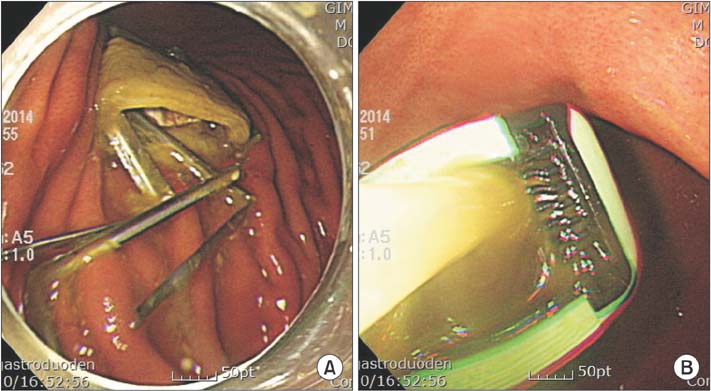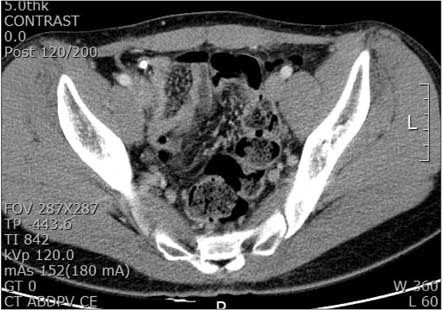Ann Surg Treat Res.
2015 Sep;89(3):158-161. 10.4174/astr.2015.89.3.158.
Acute appendicitis caused by foreign body ingestion
- Affiliations
-
- 1Department of Trauma Surgery, The Armed Forces Capital Hospital, Seongnam, Korea. lukelike@yonsei.ac.kr
- 2Department of Emergency Medicine, The Armed Forces Capital Hospital, Seongnam, Korea.
- KMID: 2166951
- DOI: http://doi.org/10.4174/astr.2015.89.3.158
Abstract
- Foreign bodies usually do not cause complications and pass through the gastrointestinal tract spontaneously. Usually endoscopic intervention is recommended within 24 hours. Cases of acute appendicitis caused by foreign bodies are very rare. In our case, we experienced successful endoscopic and surgical treatment of a patient with ingestion of razor blade and some unrecognizable foreign bodies. A 22-year-old soldier was admitted with a small quantity of hematemesis and epigastric pain. We performed emergent endoscopy and successfully removed several foreign bodies. After 17 days, we performed appendectomy to remove the remaining foreign body and to relieve the symptoms. There is no doubt that endoscopic intervention is definitely useful method to remove foreign bodies. If there is no spontaneous drainage of the foreign body from the appendix, an appendectomy must be considered to remove the foreign body and prevent surgical complications such as appendicitis, periappendiceal abscess, and perforation.
Keyword
MeSH Terms
Figure
Reference
-
1. Kay M, Wyllie R. Pediatric foreign bodies and their management. Curr Gastroenterol Rep. 2005; 7:212–218.2. Antonacci N, Labombarda M, Ricci C, Buscemi S, Casadei R, Minni F. A bizarre foreign body in the appendix: a case report. World J Gastrointest Surg. 2013; 5:195–198.3. Wu WT, Chiu CT, Kuo CJ, Lin CJ, Chu YY, Tsou YK, et al. Endoscopic management of suspected esophageal foreign body in adults. Dis Esophagus. 2011; 24:131–137.4. ASGE Standards of Practice Committee. Ikenberry SO, Jue TL, Anderson MA, Appalaneni V, Banerjee S, et al. Management of ingested foreign bodies and food impactions. Gastrointest Endosc. 2011; 73:1085–1091.5. Simkovic D, Hladík P, Lochman P. Unusual cause of the acute appendicitis. Rozhl Chir. 2004; 83:365–367.6. Park JM, Kim SY, Chung IY, Kim WS, Shin YC, Kim YC, et al. A case of successful endoscopic and conservative treatment for intentional ingestion of sharp foreign bodies in the alimentary tract. J Trauma Inj. 2013; 26:304–307.7. Klingler PJ, Seelig MH, DeVault KR, Wetscher GJ, Floch NR, Branton SA, et al. Ingested foreign bodies within the appendix: a 100-year review of the literature. Dig Dis. 1998; 16:308–314.8. Wakeley CP. The position of the vermiform appendix as ascertained by an analysis of 10,000 cases. J Anat. 1933; 67(Pt 2):277–283.9. Benizri EI, Cohen C, Bereder JM, Rahili A, Benchimol D. Swallowing a safety pin: Report of a case. World J Gastrointest Surg. 2012; 4:20–22.10. Ozkan Z, Kement M, Kargı AB, Censur Z, Gezen FC, Vural S, et al. An interesting journey of an ingested needle: a case report and review of the literature on extraabdominal migration of ingested foreign bodies. J Cardiothorac Surg. 2011; 6:77.
- Full Text Links
- Actions
-
Cited
- CITED
-
- Close
- Share
- Similar articles
-
- Appendico-colonic Fistula
- Prevention and management of foreign body ingestion and aspiration during the dental treatment
- Ileal Perforation Caused by Ingestion of Multiple Magnets
- Clinical analysis of acute drug intoxication and foreign body ingestion in Wonju: comparison between the 1990s and the 2000s
- The survey on foreign body ingestion and aspiration during the dental prosthetic treatment






